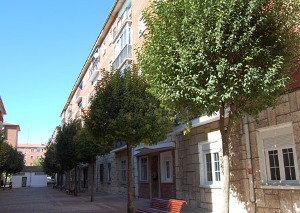Dec 15 2014
One of the biggest challenges of retrofitting projects is to make them attractive to residents. Now, one of them, the EU-funded project R2CITIES, is analysing the initial first feedback received from residents of the Cuatro de Marzo district. And there is a lot at stakes.
Being successful will help to replicate and extend these solutions elsewhere. “[our showcase site] is a mirror to [what can be done in] other European cities,” says César Alonso González, general manager of a company for land and housing, called VIVA (Sociedad Municipal de Suelo y Vivienda), which is owned by the Valladolid municipality, in Spain. VIVA is a partner in the project, due to be completed in July 2017.

This project also includes two other showcase sites: namely Kartal, in Turkey, and Genoa, in Italy. But the Cuatro de Marzo showcase in Valladolid is more complicated than the other two, as it includes private householders. This means that for retrofitting to proceed, a majority of apartment owners in each building has to agree on such work, according to Alonso González.
The level of retrofitting work is manyfold. The simplest renovation package is the addition of a thermal insulation envelope around the building. The complete solution includes the replacement of individual gas boilers by a small district heating that includes a biomass boiler and the installation of a lift. The creation of this small district heating is an important decision for residents. The installation is a joint decision between several buildings, as it requires changing habits as the boiler is no longer individually, but centrally-controlled, which may be perceived negatively by owners who are older people, according to Alonso González.
Since the heat network is financed by public funds, it should not be an obstacle to convince users. But some have recently undertaken work in their own home. “They understand the benefits of the actions, and despite being incentive subsidies, [they] don't want to spend more money,” says Alonso González. Then, there are people who are against any municipal initiative, for ideological reasons. Nevertheless, he believes, there will be a very important number of requests for change from residents.
By contrast, the Lavatrici neighbourhood owned by Genoa Municipality is in a different situation. “It is very easy to engage the people in this project,” says Margherita Scotto, a civil engineer at D’Appolonia, an engineering and consultancy company, based in Genoa, Italy and one of the project partners. They have been delivering questionnaires to people, just to have an idea of the level of user acceptance of this initiative.
The showcase area in Genoa is part of a larger residential district. Some tenants—who have not been involved in the project—have been asking why they are not addressing the whole district. “The Genoa team has decided to exploit this opportunity, with limited available resources,” says Scotto. She adds: “but of course, in the future, the intention is to replicate the [retrofitting] intervention, should we achieve the planned benefits from this project.”
Similarly to the Spanish showcase, future replication of the project findings in the San Pietro district of Genoa would require private owners’ consent to invest in retrofitting solutions. And this could represent a barrier, Scotto tells R2Cities. If good results are achieved, the models applied and developed within the other demo site could also be used as guideline, Scotto believes.
For the success of such initiative, it is essential that the benefits are visible to people. For example, residents who benefit from the project could spread the news to others residents of the benefits of thermal insulation and of lower spending on heating, says Alonso González. Finally, Rubén García, the project coordinator from CARTIF, hopes to have a global project document that analyses all the case studies, all the possible solutions and shows results. This will help to replicate the model in other cities, he believes.
A similar initiative about energy retrofitting is EU-funded ZenN project. Part of this project showed lack of knowledge and interest for energy efficiency among residents and building owners. “The mistrust is generated by ignorance. People do not understand why they need to improve the energy efficiency of their homes beyond window changes,” says Francisco Rodríguez Pérez-Curiel, R&D project manager in Tecnalia, Bilbao, Spain, who is also the project coordinator of ZenN. Sometimes the barriers are cultural differences too, he tells R2Cities. Countries of Southern Europe, for example, tend to reject forced ventilation solutions; indeed the most widely used solution is to open a window for ventilation.
In his experience, residents check improvements in comfort and reduction of consumption, following retrofitting. This lead to a situation where “satisfaction is very high,” he believes. He adds: “It's very easy to perceive the advantages when you can see the transformation of the neighbouring building,” adds Rodriguez Pérez-Curiel. However, he believes, public administrations must help the poorest, both by increasing their financing capacity in developing retrofitting projects in their own housing stock and in supporting highly visible actions.
Article by Joan Carles Ambrojo